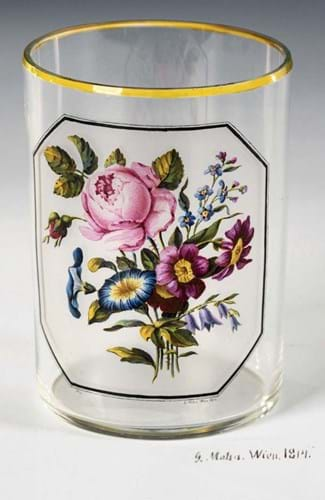The 3½in (9cm) high glass was decorated with a bouquet of summer flowers around a large rose, delicately painted in enamel.
The owner, a local collector, was not aware of the miniscule signature on the base of the painting which goes a long way to explain the determination of the bidders. On the right one can decipher G. Mohn. Wien. 1814. This identifies the beaker as the work of one of the most accomplished glass painters of the Biedermeier period.
Gottlob Samuel Mohn, the son of the porcelain and glass painter Samuel Mohn, was destined to follow his father’s footsteps. He is generally considered to have surpassed the artistic achievements of his father, producing exquisitely executed landscapes, views of towns, historical and allegorical scenes as well as floral motifs.
Heinrich inscription
The fact that Mohn was not the sole creator of the floral beaker in the auction can be discerned from the second, equally tiny inscription, on the left of the painted panel: the initials Ah.p. These show that (Johann) August Heinrich was responsible at least in part for the painting (p = pinxit).
In c.1812 Heinrich had studied alongside Mohn at the art academy in Vienna and for some time worked for his friend and colleague, before becoming a famous painter in his own right, preferring canvas to glass. He was involved closely with the colony of Romantic painters who were active in the Austrian capital. His promising career was, however, cut short by his death from consumption in 1822.
Joint works by Mohn and Heinrich are very rare, a fact not lost on the bidders. The auction house had set the starting price at a modest and enticing €240.
Phone and online bidders and their competitors in the room drove the price ever upwards. At the close of play, an Austrian collector competed with a German counterpart. The latter won the day with their bid of €30,000 (£25,640).















